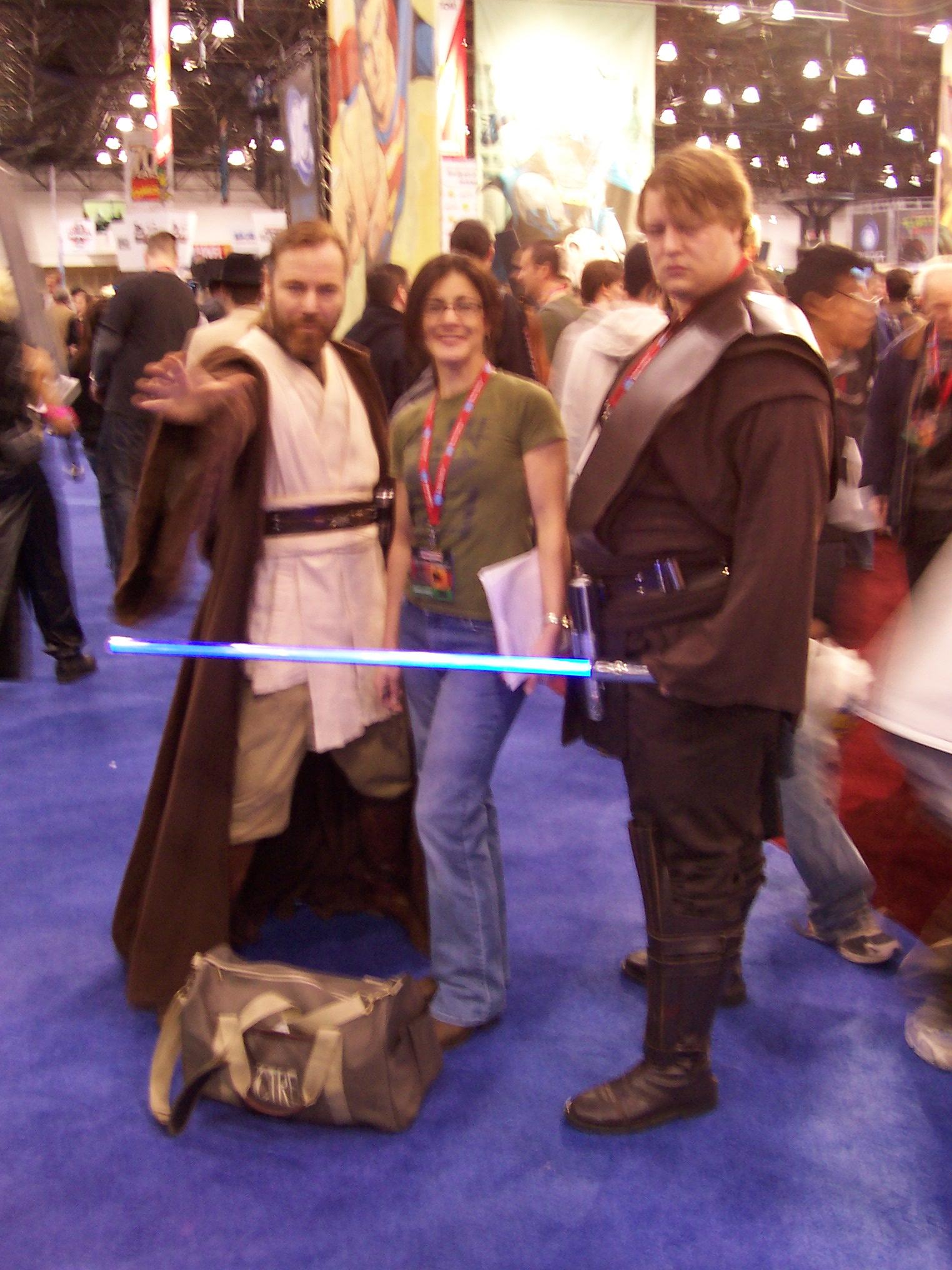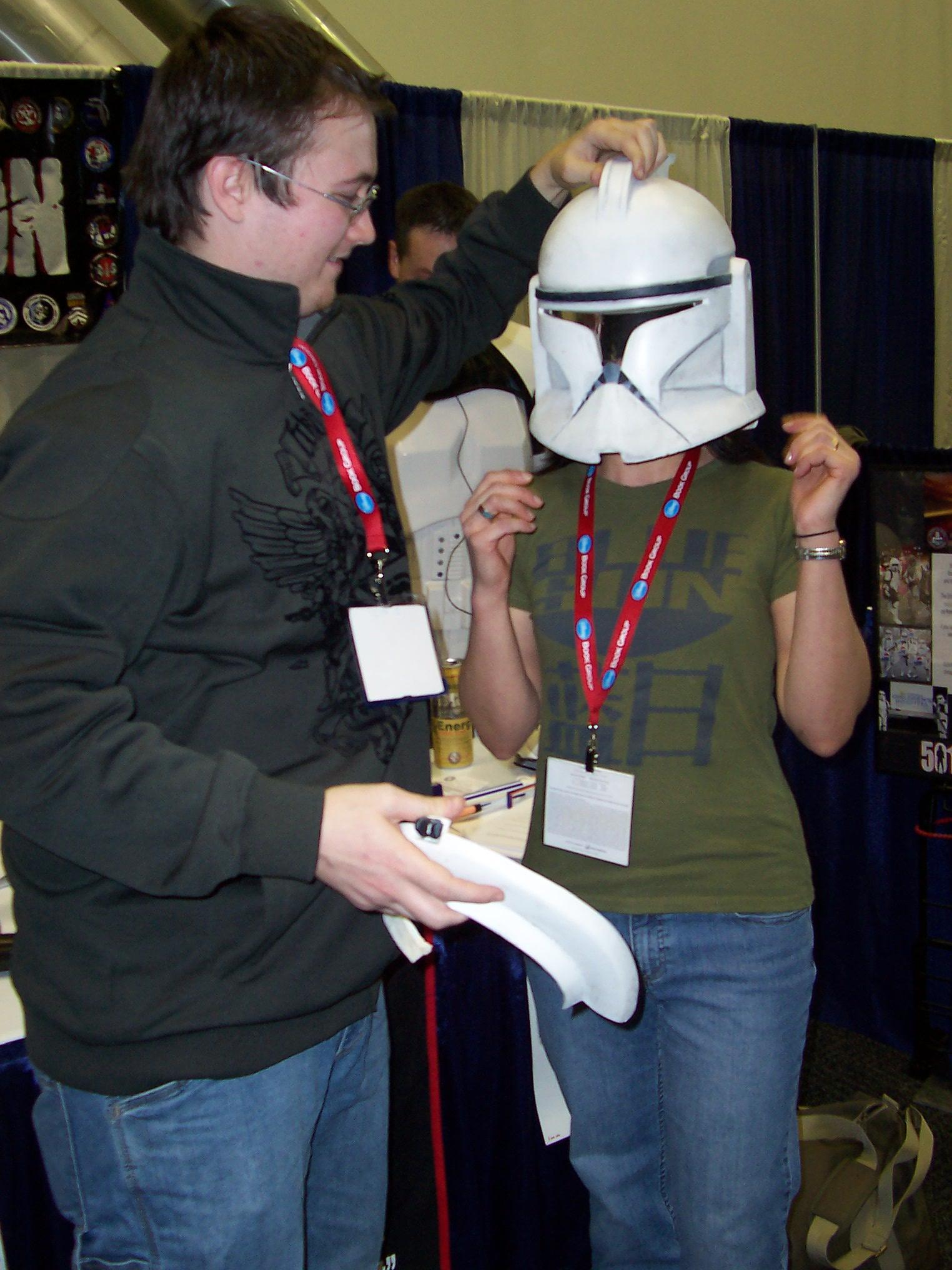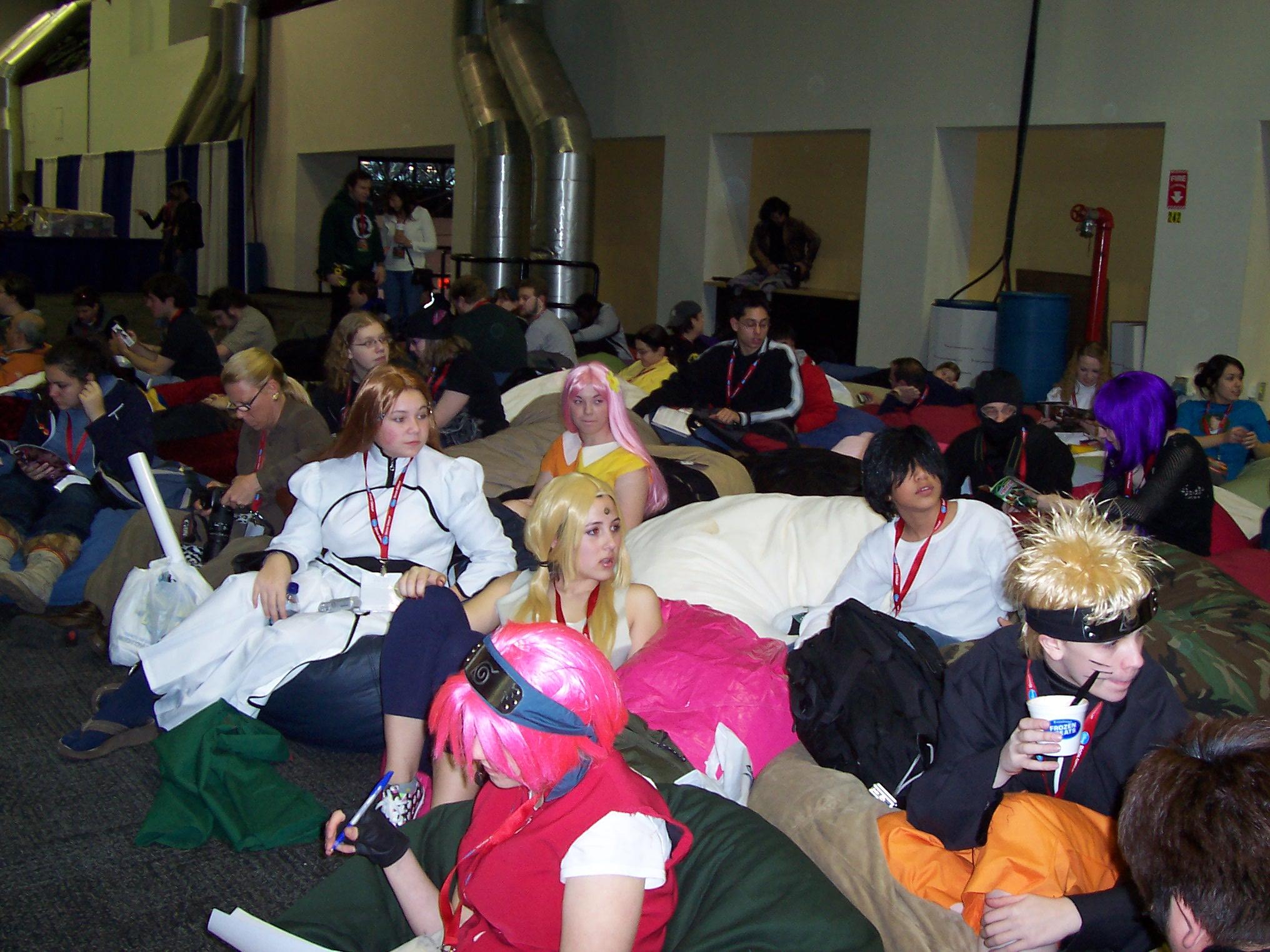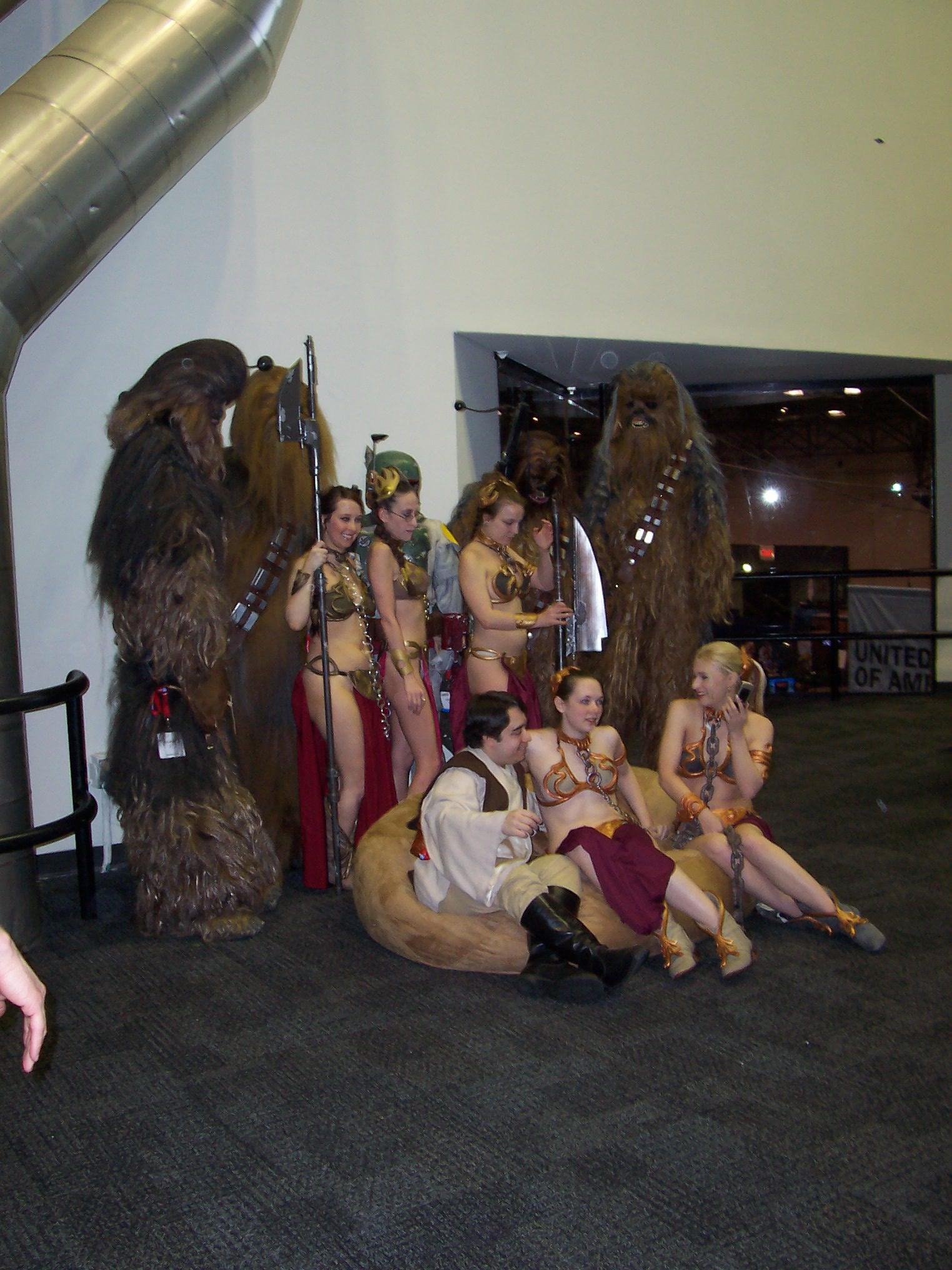1. Introduction
[1.1] Obi-Wan looked amazing! His costume was meticulously detailed, right down to a film-quality light saber. He walked a fine line between staying in character, which was delightful because he was really good, and discussing the well-organized Star Wars cosplay (costume role-play) fan base (figure 1). I became even giddier at finding no fewer than five slave Leias. And when asked by a storm trooper if I wanted to try on the helmet, I said, "Hell, yes" (figure 2). Examining identity and how people choose to perform it places me in unusual circumstances. In this case, the experience was both enjoyable and enlightening.

Figure 1. Obi-Wan Kenobi, Jennifer Gunnels, Anakin (Star Wars III: Revenge of the Sith, 2005). Photo by Nicole Fellows. [View larger image.]

Figure 2. The author as clone. Photo by Nicole Fellows. [View larger image.]
[1.2] I was at the 2009 New York Comic Con to ask Obi-Wan and his friends why they did this. Very few venues exist for adults to play dress-up, with Renaissance festivals, comic and other media conventions, and live-action role-playing games comprising the bulk of these venues. This sort of behavior is expected of people in their formative years—children and teenagers—where they try on and receive feedback about the "range of possible extensions of the self" (Elliot 1986, quoted in Kaiser 1996:162). What might be the reasoning behind the behavior of adults doing so, especially after primary socialization has occurred? Susan B. Kaiser, in her study of clothing, wonders whether role-play dress is important "in terms of providing some means for 'escaping' from mundane daily routines, as well as for expression of creativity," but she concludes that "little is known about fantasy dressing; this is an area with a great deal of potential for contributing to an understanding of creativity and self-expression" (1996:163). Very little has been written on the subject, beyond mentioning that this behavior happens.
[1.3] As my ongoing research is showing, the behavior isn't necessarily mere escapism. Adults engage in costumed role-play to explore an identity that may not be practicable in everyday life. For comic and other media conventions, the behavior also has a social, communal nature. In the case of Star Wars, members of Generation X, who saw the original Star Wars trilogy, are reminded of its effect on their childhood. Star Wars helped socialize this generation and may be providing a template for their own parenting, especially because current socioeconomic issues are not dissimilar to those of 1977. In this way, cosplay, as a performed identity, can provide a means of permitting individual agency and social commentary on current and past social stresses.
2. Ordering identity
[2.1] When examining performed identities, such as those seen in Star Wars cosplayers, two things should be kept in mind: How is the identity being ordered? And what is the framework surrounding its construction? These are important not only because identity is fluid, but also because it can be perceived or misperceived on the basis of the social framework into which it is being projected. To answer the first question, Henry Tajfel (1982) posits that identity is self-determined, and that a person can have multiple identities in place. The individual determines the dominant identity through hierarchically organizing potential identities—for instance, I am a woman, an academic, a mother, and a friend, among other identities. However, the ordering of identity is largely based on the notion of framing, which determines not only how we decide to order our identity in that moment, but also how others will either read or misread what is presented (Goffman 1959). A frame is usually socially and historically determined: I wouldn't dress as slave Leia to go to work, and regardless of Leia's introduction to the cultural consciousness, no one would dress like that in the 1950s.
3. Cosplay and the New York Comic Con
[3.1] Some identities can be performed and explored as cosplay. The study of cosplay and its practice specifically within the United States is sparse. Most studies of cosplay are framed within its expression within Japanese popular culture, particularly manga and anime, and its export to the United States and other points West (as can be seen at http://www.cosplay.com/); other studies discuss cosplay in terms of gender. What has not been examined is its nature as performance and as identity play as found at sites such as conventions. The site of my fieldwork, the New York Comic Con, began in 2006. In 2 years, it has grown explosively from a total attendance of 33,000 to a total attendance of 67,000 in 2008. It is the second largest popular culture convention in the United States. The con is an amalgam of material, cultural, and visual consumption. In addition to vendors, areas are set up for gaming tournaments, demonstrations, film previews, and media podcasts; other activities include seminars and professional panels (with writers, artists, and other professionals), and artists autograph material and network for future work (like a job fair).
[3.2] When I attended the Comic Con in 2009, very few of the audience choose to participate in costume—as an offhand guess, I'd estimate that perhaps less than 5 percent of the attending audience was in costume—although all of them were having a good deal of fun (figure 3).

Figure 3. Non–Star Wars cosplayers. Photo by Nicole Fellows. [View larger image.]
[3.3] The quality of the costumes varied but tended toward the virtuoso, with a great deal of detail, such as the costume worn by Obi-Wan, a cosplayer who became one of my interview subjects. In fact, I was surprised to find that many of the cosplayers drew from the Star Wars universe (figure 4). I took an informal tally that broke the character representations down as follows: one Obi-Wan Kenobi, one Anakin Skywalker (both from Star Wars Episode III: Revenge of the Sith, 2005), five slave Princess Leias (Star Wars Episode VI: Return of the Jedi, 1983), four Wookies, one Han Solo (Star Wars Episode IV: A New Hope, 1977), three Imperial officers (two men, one woman), and, at a conservative guess, a dozen Jedi and perhaps another 8 or 10 storm troopers from the 501st Legion, Vader's Fist, a national Star Wars costuming organization. All were networked with groups specifically created to assist people in cosplaying the characters from the Star Wars universe (note 1). Intrigued, I found myself examining the cosplayers' possible purposes for choosing these specific identities.

Figure 4. Slave Leias and Wookies. Photo by Nicole Fellows. [View larger image.]
4. Fandom through performance and fetish
[4.1] When observing cosplayers, regardless of the universes they represent, some might wonder why they choose to connect with their fandom through performance, as opposed to other manifestations of fan engagement. Two reasons in particular come to the fore: the immediacy of the physical, and applying archetypes/fetishes to aspects of personal identity. Francesca Coppa (2006) notes that fanfic can be read as performative when viewed through the lens of Richard Schechner's well-known ideas on performance. Fiction, however, lacks the level of real, constructed immediacy found in a true performance environment. Yes, you can imagine that you are Obi-Wan Kenobi as you read a fan text, but wouldn't you rather be him? Of course, this isn't possible, but cosplay serves as a middle ground.
[4.2] Further, Schechner's concept of the subjunctive mood in performance (1985:37)—not me, not not me—allows people to incorporate aspects of the character into their own identity. This can, and sometimes does, lead to a fetishization of both costume and character. Donning the costume, or even simply carrying a small prop such as a light saber, allows cosplayers to tap into the character as archetype and the costume piece as fetish: "The fetish is empowering, transgressive of the realm of the everyday and mundane, and transforms the user, thus marking a return in a sense to the original meaning of the fetish" (Wetmore 2007:177). Essentially, both become a totem, or a meaningful emblem or symbol, and "people will act towards totems in such a way based on the meaning they have given the totem." Meaning will then manifest as social interaction (Garrard 2008:17).
[4.3] In an interview I conducted on February 7, 2009, Obi-Wan shared with me his view of why he admires Obi-Wan—what meaning he has given his chosen totem: "The nobility, the warrior, the leadership, following the Jedi Code, all these things, I think, make him that great archetype that we've come to know and love." When I asked him more specifically if there were any aspects of Obi-Wan that carried over into his everyday life, he replied,
[4.4] I'd like to think there's a lot, but I could certainly be more noble. I could certainly be a better leader in my own life. But when it comes right down to it…I could be a better person in my own life. Probably when I step into costume, into the role, I think I become a better person than I am in real life and could certainly aspire to be as good as Kenobi.
[4.5] Becoming the character acts as transformative moment: he is not Kenobi, but not not Kenobi. As he remarks, aspects of the character are specifically tied to donning the costume. He may not believe that he carries specific aspects of character identity over into everyday life, yet they are available to his identity when in costume.
[4.6] Another of my interview subjects, Steve Koets, a member of the 501st Legion, summed up being a storm trooper as a question of enjoying the sense of shared community. In an e-mail interview I conducted with him on January 22, 2009, he stated that he participates because he "never really let go of an aspect of childhood that lets you truly believe that you're a race car driver whilst peddling your big wheel down the sidewalk. Or Luke Skywalker flying down the Deathstar trench." An anecdote he shared further stresses the aspect of his childhood love of the Star Wars universe:
[4.7] A few years ago my wife threw a 40th birthday party for me. Knowing my closet love for star wars (from my childhood)…[she] surprised the dickens out me with a star wars theme party. Everyone came in a costume Cantina Band DJ, full-size Jabba the Hut Statue, Millennium Falcon cake my wife in a Princess Leia metal bikini…and my indoctrination into the 501st [Legion]…I absolutely was impressed by the squad of storm troopers, Darth Vader, Bobba Fett and many more that marched into the room to present me with my present an actual set of storm trooper armor. The costumes were very screen accurate and worth up to $3000 a piece after being "sworn to the empire"…what is cooler than being a storm trooper?
[4.8] Indeed, what is cooler than being a storm trooper? Determined to find out why so many cosplayers were drawn to this role, I asked many storm troopers, all of whom were either already members of the 501st or were in the process of requesting membership, about the appeal of this role. Koets replied, "They are the 'misunderstood bad guys'…the troopers began with the clone army—OWNED by the republic—they were the military force that protected the rights of Democratic government—that turned into one run by the emperor—but because they were owned—and had allegiance, they ended up with the bad rap" (e-mail interview, January 26, 2009). Another member of the 501st (figure 5), in an interview at the con (February 7, 2009), remembers being 7 years old: for him, the first guys who really stood out in the films were the storm troopers. Now that he's old enough, he "can afford to indulge in having wanted to be a storm trooper."

Figure 5. Member of the 501st and Jennifer Gunnels. Photo by Nicole Fellows. [View larger image.]
[4.9] The most interesting similarity with nearly all of the Star Wars cosplayers was their ages. Most of them represented a spectrum of Generation X, which I'm defining following William Strauss and Neil Howe (1992) as members of the population born between 1961 and 1981. The release of the original trilogy films (1977, 1980, and 1983, respectively) meant that members of this generation were impressionable children. The content of the films becomes progressively more complex, thus presenting more complicated ideas concerning life to progressively older (and appropriately so for the messages) audiences. As an example, I fall into the middle range of Generation X. At the release of the films, I was 9, 12, and 15—very age appropriate for considering what the films had to say about navigating the path to adulthood and society.
[4.10] Why Star Wars? Why now? Several cosplayers, particularly those who decided on characters from the original trilogy, pointed to a backward entry into cosplay: participation began with their children's interest in the franchise, even though they themselves had been fans since childhood. Koets, like many others I interviewed, found that he connected with his children through his own childhood love of Star Wars. Koets and one of the Wookies I interviewed were pulled into Star Wars cosplay through building an R2D2 robot with their children. Koets "hopp[ed] around the house for a good lightsaber battle [with his children]," and the Wookie cosplayer, after completing the R2D2 model, felt compelled to have a costume to go with it. When I met him at the 2009 Comic Con, he even carried his own childhood Chewbacca action figure.
[4.11] The fact that they are parents is telling. Through their involvement, the adults reaccess their memories of seeing the original film and how this material helped them navigate the circumstances of their own childhood. They revisit these memories while immersed in similar social circumstances to their first viewings. Then, as now, a new generation of children are discovering Star Wars while the country is in dire socioeconomic circumstances. As children, members of Generation X found themselves thrust into a period of rapid value shifts, the breakdown of the nuclear family, and economic upheaval. In addition, the parenting style of the baby boomers, in opposition to their own strict upbringing, tended to leave their Generation X children to their own devices. This proved detrimental in bequeathing the cultural information—"the teaching of society's acceptable values, norms, beliefs, and actions" (Garrard 2008:9)—necessary for navigating a path to adulthood. Star Wars filled the gap.
[4.12] Several scholars, such as Bruno Bettelheim (1991), explain how fairy tales and myth provide a vehicle for this teaching. Today's fairy tales and myths are expressions of popular culture—films, TV shows, video games. The Star Wars films are relevant here, as producer and film critic Dale Pollock acknowledges in his remarks about the mythic power behind the original Star Wars film: "Children get the message—they know eventually they'll have to leave home, take risks, submit to trials, learn to control their emotions, and act like adults. What they don't know is how to do these things. Star Wars shows them" (Garrard 2008:67). Children of Generation X understood, as most children eventually do, that they would need to learn to negotiate the world as adults. They knew the "what" but not the "how," and Star Wars bridged that gap: George Lucas used the structures of the mythic journey throughout the original trilogy, and Generation X in turn used it as a model for navigating their path to adulthood. All of this blossomed in 1977's sociohistorical context: economic downturn, rising housing prices, rising gas prices, rising inflation, and falling real wages (Garrard 2008:87). Sound familiar?
5. Conclusion
[5.1] As with any area of study, particularly those (like this study) with scarce secondary literature to consult, my examination of Star Wars cosplay within the New York Comic Con raises more questions than it answers. Why do cosplayers choose the characters they do? How do cosplaying communities, like the 501st Legion, work on a larger scale? Are cosplayers at other comic cons portraying Star Wars characters for similar reasons? Why do people choose cosplay over other forms of fan participation—or do they participate in other fan areas as well? If so, to what extent?
[5.2] The Star Wars cosplayers are clearly tapping into their childhoods: today's social context eerily mirrors the context that members of Generation X grew up in, and the children born to Generation X are growing up in parallel circumstances characterized by economic instability. For some cosplayers, dipping into the Star Wars universe may be a way to cope, as well as a way to share coping strategies with their own children—to pass on the same myth that enabled them to negotiate their own growth within our culture. Will we point them in the direction of Luke Skywalker and Obi-Wan Kenobi to learn how to best negotiate the times? In all honesty, I would like to think so. Perhaps they will forge a New Jedi Order to balance the mistakes of the Knights of the Old Republic.
6. Acknowledgments
[6.1] A version of this paper was presented at the 2009 PCA/ACA Conference in New Orleans for the Faires and Festivals group. I thank Nicole Fellows for her assistance in gathering field material and shooting footage at the 2009 New York Comic Con.